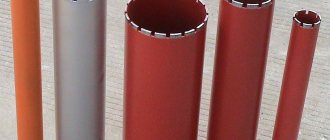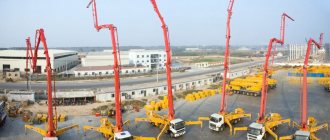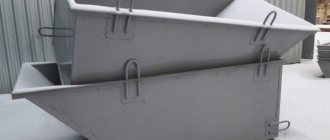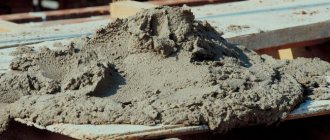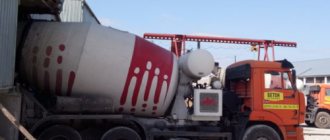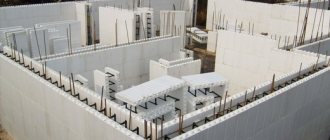Beton-House.com
Website about concrete: construction, characteristics, design. We combine the experience of professionals and private craftsmen in one place
Such a car evokes involuntary respect by its appearance alone.
The ability to combine a mixer and a concrete pump in one unit for many years remained a pipe dream of domestic concrete workers. At the same time, in the West, a mixer with a concrete pump was in full swing used on almost all more or less significant construction sites. And it was not just applied, but also progressed by leaps and bounds.
Thanks to domestic enthusiasts for the introduction of technical innovations in the construction industry, an increasing number of such machines are appearing in our country. Will such universal equipment be able to completely replace the mixer and concrete pump as separate technical units? How tangible is the economic effect of using highly versatile equipment on a construction site?
It may be worth remaining committed to the traditional technology of separate delivery and separate pumping of concrete to the placement site using separate machines and units. The questions are largely rhetorical and in many ways not indisputable, but it’s definitely worth trying to understand the nuances of using such a construction “miracle weapon.”
Born to crawl, cannot fly
Concrete work sites do not always resemble a golf course.
The surface of a construction site very often resembles, if not a battlefield, then at least a lunar landscape. The tempting idea of combining in one product a heavy, clumsy concrete mixer on wheels and a mobile concrete pump, the laying end of which can easily float at a height of dozens of meters, has captured the best design minds of progressive humanity for decades.
And, as usual, problems of a purely technical nature became an obstacle. At that time, there were objective reasons that did not allow the creation of compact, productive and reliable devices that could be placed on a standard automobile chassis, without exceeding the mass-dimensional characteristics.
Very often the matter did not go beyond prototypes or a very small series. The ice began to break at the turn of the 1970s-80s of the last century, when the giants of the Western technical industry began to introduce fairly massive galaxies of such devices to the market. The design genius won and the mixer with the pump went into wide production.
Technical ABC: main components and assemblies
- The main unit, a kind of foundation of the overall design, is the automobile chassis. There are a number of difficult, but completely legal and justified requirements for it. The chassis must be sufficiently lifting, maneuverable, have good weight distribution along the axes, and have a reasonable margin of strength and maneuverability when operating far from the greenhouse conditions of a construction site.
- A concrete mixer drum is installed on the strong backbone of the vehicle, with all the necessary technological piping in the form of a water tank, drives, control devices and other elements of the completed technological chain.
- On the intermediate platform, which is not occupied by the mixer, a concrete pump is installed with elements of a system for transporting ready-made concrete in space, ensuring the supply of the mixture in the widest possible range, both horizontal and vertical working horizons.
- Since the entire complex drive system of the mixer drum, concrete pump pipelines and other facilities is driven by hydraulics, the hydraulic system has every reason to be distinguished as a separate and very important aggregate part, in turn, consisting of many separate and interconnected elements. The main ones are a hydraulic pump, hydraulic lines, control and distribution systems for hydraulic flow, working parts, and these can be hydraulic motors, hydraulic cylinders, hydraulic rotary heads and more.
- And like a cherry on top of this whole layered high-tech cake is a digital system of objective control and accounting. On outdated models, such a system was implemented on an analog element base, which also implies significantly less capabilities compared to digital ones.
So what is it, a concrete pump with mixer or a concrete pump mixer?
Designs of domestic and foreign production
The world first heard about standardized concrete trucks in the thirties of the last century. In America, these machines are called concrete mixer trucks. They were intended to transport dry composition, which was mixed with water on the way to the construction site. Modern technology is no different in functionality from its predecessors; only the appearance and mechanisms have been improved.
The most popular domestic manufacturers producing concrete trucks are MAZ, Ural, KamAZ, KrAZ. Foreign models are represented by Mercedes cars - Benz, Volvo, Ford, MAN, Scania, Iveco.
Concrete trucks with a mixer from Russian manufacturers are represented by models with a chassis that are equipped with an individual power unit, a capacious drum that operates in autonomous mode. Such concrete trucks show excellent performance at temperatures from -20° to +40°C.
Foreign concrete mixer trucks are often represented by machines with high productivity, which are easy to maintain due to the ergonomics of the units and blocks. Multifunctional installations are equipped with heating elements that allow the finished mortar to be heated at the installation site to +70°C, which is important for winter construction.
Higher, further, stronger
It is impossible to answer the above question unambiguously. A lot depends on the fundamental tasks that the machine solves at the site.
If the customer is tasked with mass concrete laying under simple conditions and with a minimum number of points, and the need to use a concrete pump stand is expressed solely in the inability to deliver an ordinary mixer directly to the place of laying (the reasons can be a variety of things, weak crumbling soil, crossing the path of communication, restrictions by vertical or horizontal dimensions, stationary fences and the like), then we can talk about a mixer, where the concrete pump performs an important, but still secondary function.
Even when carrying out simple work, as in the photo presented, a concrete pump mounted on a mixer significantly expands its functionality
If there are many laying points on the site that require a small amount of concrete, involve frequent movement around the perimeter, and the laying itself requires an accurate and dosed supply of mass, then it makes sense to say that the work is carried out by a concrete pump with a mixer.
Moreover, the mixer plays the role of a transportable and permanent ready-to-use supply of ready-mixed concrete. This feature eliminates the rather troublesome function of constantly combining a mixer and a concrete pump at one operating point.
For large volumes of concrete work, a mixer with a pump must be paired with a simple mixer
Principle of operation
The operating principle of this technique is quite simple. It consists of alternately closing and opening valves through which the mixture passes. A piston is used to push it out. When it moves, the concrete ends up in a special hole.
While inside the mixer, the solution is constantly mixed. This happens until the mass is used for its intended purpose.
Concrete supply using a pump Source specteh-crimea.speczakaz.info
What is good and what is bad
In this section we will try to consider the strengths and weaknesses of such equipment, and they certainly exist.
The unconditionally positive ones include:
- Possibility of laying in places with limited maneuverability. At fences and fences, above or below overhead communications, through trenches and pits. Very often, narrow space does not allow two units of equipment, a mixer and a concrete pump, to work simultaneously and synchronously.
- A mixer with a concrete pump allows you to lay concrete on floors at heights that are not reachable for tray laying from a mixer.
- When laying a small amount of concrete, but which needs to be done using a concrete pump, using such equipment can sometimes reduce the cost of work by half.
- The operation of this type of equipment in the transport fleet of a concrete hub allows for a 170-220% increase in the efficiency of using equipment by minimizing idle runs and deliveries to a potential customer’s site. This is especially true for small batches of ready-mixed concrete, from 2 to 9 cubic meters.
If carrying out this type of concrete laying is quite possible for a simple mixer
Only a concrete pump can pull off such a trick.
As for the negative aspects when using such very specific equipment as a concrete mixer with a pump:
- The cost of a mixer equipped with a concrete pump is an order of magnitude more expensive than a mixer of similar volume without one.
- The costs of operating such a vehicle in idle mode are significantly higher due to the higher weight.
- Repair and maintenance of such equipment are complex and expensive. Very often, design solutions are made in the form of a technical compromise, which entails quite serious consequences in case of non-compliance with service regulations.
- High technical complexity and low production culture of the domestic user very often lead to emergency breakdowns.
- The high cost of spare parts, the lack of domestic analogues and high-quality and competent service make repairs a very difficult task.
- Equipment of this class places increased demands on the driver of the automixer. In addition to simple skills in placing concrete using trays, he must have strong skills in manipulating the complex and capricious concrete pump delivery system. Sometimes, in some cases, it is necessary to add an additional assistant to the vehicle crew.
- The capabilities of such a hybrid are inferior to the capabilities and technical characteristics of similar designs in a “pure” design.
Very often, the capabilities of a highly specialized tool turn out to be an order of magnitude higher than the capabilities of a hybrid
The Magnificent Seven
Our most popular units are European-made units. They are distinguished by the most optimal price-quality ratio.
The products of American companies are also worthy of respect, however, a number of technical features, in particular the inch threaded connection system and the difficulty in providing spare parts and consumables, forces those who want to acquire such a machine to look towards Europeans, even used ones. Chassis for mixers and concrete pumps for the European market are supplied by the so-called “Big Seven” of the European automobile industry and it is worth looking at them in more detail.
The actual working mechanisms of concrete pumps and mixers are also produced by many companies. The most famous and authoritative are LIEBHERR, Putzmeister, CIFA.
The first is known, in addition to pumps, for its unique cranes and quarry equipment. And the latter gained popularity precisely in the combination of equipment for preparing and mixing concrete and pumps for pumping it.
Radio remote control systems for concrete pumps are becoming an increasingly commonplace and familiar thing in the product line of a reputable European manufacturer
Both rotary and piston pumps have a well-thought-out design based on proven technical solutions. The “heart” of any concrete pump is the gate, which is characterized by durability, wear resistance and fairly simple installation, which ensures convenient replacement of consumables.
Currently, leading manufacturers are constantly working to improve the strength of the gate by both improving its design and using new revolutionary materials for its manufacture.
The car chassis is the foundation of the entire complex system
As for the car chassis, the performance, or rather the effective performance of the entire system as a whole, directly depends on its design and potential capabilities for its rejuvenation to various hydraulic, pneumatic, mechanical systems.
DAF
The Dutch manufacturer has long and successfully supplied chassis for installation of various types of superstructures for various purposes. Simple and unpretentious cars of previous generations are readily purchased by private owners on the secondary market. The chassis is repairable, the manufacturer has developed an excellent service system.
It is worth mentioning separately the small Dutch manufacturer of special chassis GINAF. These cars are rightfully considered the most durable cars on the European continent. Multi-axle design, large load capacity, and hydraulic suspension make it a very serious player in the market of special and construction equipment.
The use of such a powerful and load-lifting chassis allows the use of a mixer and concrete pump with very good performance characteristics
SCANIA
Swedish cars of this brand have long and deservedly won the love of builders in many parts of the world. The G series vehicles, specially designed for harsh operating conditions, are especially reliable. It is worth noting that the cars of this brand are the most economical of their classmates.
The Scandinavians offer to implement dozens of various equipment options in one chassis
VOLVO
Another Swedish brand with an excellent reputation. It should be noted that these cars are among the most expensive, but at the same time they lose the least value in the secondary market. Both Scandinavian brands have a developed dealer and service network, especially in the northern regions of our country.
A car chassis in such an “evil” design is a real find for the harsh domestic builder
Mercedes
The products of the Daimler concern have been known to us since the times of the USSR, when its tractors formed a significant part of the Sovtransavto fleet. An interesting acquisition on the secondary market. It has a solid resource and a fair margin of safety.
In addition to the real giants, in the Daimler Benz model range there are also little ones equipped with quick-release modular equipment for a wide variety of purposes.
MAN
Another German brand. It has proven itself well as a mass product in large companies supplying ready-mixed concrete to sites. Its range includes reliable four-axle chassis, suitable for mounting large-volume mixers and powerful concrete pumps.
German cars with a wolf emblem on the radiator grille have long been associated with the reputation of a humble worker.
Renault
French chassis are in less demand here. Some concern is caused by the frame design, which has an insufficient reserve of excess strength when operating on the difficult terrain of construction sites.
A sharp difference in heights, causing diagonal hanging, which is not always handled correctly by the suspension and deforming loads are transferred to the frame.
The Renault line also includes a model for difficult operating conditions - Kerax
IVECO
The Iveko concrete mixer pump is most often equipped with a superstructure from the Italian company CIFA. Which gives a very good and long-lasting result. In addition, such installations are among the most affordable on the secondary market. Moreover, most of them have a good residual service life, and taking this into account, the price for such a kit looks very attractive.
Even very old models in the hands of a zealous owner look like they just came off the assembly line of a car factory
Nice European trio. Or Chinese?
It is no secret that the pioneer in the creation of concrete pumps was the Schwing , which released its first oil-hydraulic concrete pump in 1957. The following year, a trailed concrete pump on a wheeled chassis was introduced, and three years later it was already equipped with a distribution mast. Since 1973, the company has launched serial production of a concrete pump with a 45-meter distribution mast. In the early 1980s. A merger took place with Stetter, and the renewed company became the largest manufacturer of concrete mixer trucks. Today, a controlling stake in the company belongs to the Chinese concern XCMG , but concrete feeding equipment is still produced under the name Schwing-Stetter and at the same production facilities.
Among the large number of models, there is also equipment for supplying concrete in confined spaces and even in the presence of obstacles. This is exactly what the S 38 SX Reptor brand truck-mounted concrete pump is, which can be installed on several types of chassis. When mounted on a 6x4 chassis, the payload is reduced to 26 tons, while maintaining high mobility and maneuverability. If you want to reduce costs, it is recommended to install the concrete pump on an 8x4 chassis with a long wheelbase, on which a P2525 pump battery with 2.5 m lifting cylinders is mounted. This design allows you to reduce the number of strokes by 20%. For example: with a productivity of 60 m3/h, the pump battery makes only 8 strokes per minute.
The wear-resistant skirt-shaped gate, the same as on other Schwing models, creates low frictional resistance to the flow of the concrete mixture, and thanks to its simple shape it is easier to clean. The gate provides access to the discharge cylinder pipe and the discharge piston, thanks to which the pump battery can be cleaned in just two strokes, which means that the concrete pump can be prepared for operation faster, and without wasting water. Economical engine operation below 1000 rpm combined with an open center hydraulic system provides high performance and significantly reduces equipment wear. The Easyflex support system adds stability in difficult working conditions. For safe operation, the operator has an intuitive Vector control panel or a remote control with a charge reserve of 8 hours of operation for precise guidance of the concrete pump boom.
From stationary concrete pumps Schwing mod. SP 1800 is one of the most popular among builders due to its high reliability and good performance characteristics. The power of the hydraulic pump is adjustable; during operation, the operator can manually specify the desired number of strokes and flow rate, which protects the drive motor from overloads. To achieve maximum productivity of 73 m3/h, the concrete pump requires only 24 strokes per minute, which is 15% less than equipment from other manufacturers. The equipment is easily transported around the construction site on a single-axle trailer. The heart of the concrete pump is a diesel engine with a power of up to 152 hp, depending on the modification. With. The working pressure when supplying concrete mortar reaches values from 56 to 101 bar. This makes it possible to pump mortar up to a height of up to 180 m and horizontally up to 500 m, making the Schwing SP 1800 particularly suitable for multi-storey construction.
CIFA company in Italy to produce a concrete mixer in 1958, and the first concrete pump in 1965. By 1975, the world's first truck-mounted concrete pump with a Magnum mixer was developed, which immediately made the company a world leader. In 1998, the company produced the largest concrete pump with a boom lift of 52 m. In 2008, CIFA was acquired by the global Chinese concern Zoomlion. Today the company offers equipment for transporting concrete under the ZOOMLION-CIFA brand. The equipment line includes stationary and truck-mounted concrete pumps.
For the 90th anniversary of the company, a special version of the concrete pump on a car chassis was released - mod. K47H. The limited edition cars feature a three-tone paint scheme of matte grey, orange and black, as well as a plate with the serial number and the company's 90th anniversary logo. Mounted on an 8x4 chassis, this pump is part of the Carbotech series, in which the last two boom sections are made of carbon fiber. The maximum productivity is 140 m3/h, the distribution boom is five-section, 47 m long.
Smartronic GOLD machine control system with improved stability control for increased work safety, especially important when outriggers cannot be fully extended. The fully removable pump group ensures efficient pumping of a variety of concrete types and aggregate sizes, reducing the number of cycles per minute for the same payload, ensuring low wear and long machine life.
Of the stationary models, PC 307 is the smallest in the line, but has proven itself on construction sites around the world. The equipment is mounted on a single-axle trailer with a drawbar, with four adjustable supports. The engine is diesel from Deutz or Perkins; it is also possible to install an electric motor. The main pump is an axial piston type with variable displacement and constant power. The pumping station creates a smooth, continuous flow and ensures efficient pumping of different types of concrete with aggregates of all sizes, with fewer cycles per minute while maintaining the same flow rate. This solution guarantees less wear and extends the service life of the concrete pump. The productivity is 30 m3/h, the hopper capacity is 300 liters. The supply of concrete mixture is possible at a distance of 500 m horizontally and up to 120 m in height. Low noise level allows you to work in dense urban areas.
In 1968, the company's first truck-mounted concrete pump was released under the Putzmeister , and just a year later their market share of truck-mounted concrete pumps was already 45%. The model range included pumps with boom lengths from 11 to 25 m, and the productivity of the concrete pumping unit reached 125 m3/h. Today, Putzmeister employs more than 3,000 people in 20 divisions around the world with an extensive dealer network in 154 countries. Since 2012, the company has become part of the Chinese Sany, but, as many years ago, under the Putzmeister brand, customers are offered a wide range of concrete supply equipment.
The new BSF 42-5.16H truck-mounted concrete pump is proof of the consistent quality and constant innovative developments. The new product can be described in just a few words: lightweight, productive, with a boom higher than 36 m. A modern concrete pump on a vehicle chassis is distinguished by its dimensions, which do not exceed current standards for size, weight and axle loads for movement on public roads. The total weight of the Putzmeister BSF 42-5.16H pump is 29,260 kg, the axle load is up to 10 tons, the productivity is 160 m3/h.
An optimally selected ratio of the geometry of feed cylinders, pistons, performance and pressure on the mixture reduces fuel consumption and increases environmental friendliness and safety of work. There is a whole scattering of electronic control systems, including the EPS pumping control system and the SN gate switching control system. The EGD graphic display with self-diagnosis function warns the operator of possible malfunctions, the PushOver system prevents the occurrence of pressure peaks that affect the rate of wear, thanks to which the concrete pump lasts longer with less wear, which means it is cheaper to maintain and more profitable to operate.
The boom is made from high-strength steel and its design, combined with supports and OSS to help install the pump in tight spaces, makes it easy to position the pump even on narrow city streets. The sleeper chassis cab will please the operator, as will the Webasto engine and cab auxiliary heater. The “cherry on the cake” will be a double-layer concrete pipeline, a high-pressure washer and a winter hydraulic accumulator, supplied as standard.
Among the best-selling stationary concrete pumps from Putzmeister mod. BSA 1409 D. The equipment is powered by a powerful 190 hp Deutz diesel engine. With. Assistance in pumping the concrete mixture is provided by a direct-flow hydraulic system. The feeding hydraulic pump, which develops a pressure on the mixture of up to 106 bar, allows you to receive and supply concrete horizontally from 400 to 950 m, depending on the mobility of the mixture. In height, such a pump is capable of delivering concrete to the level of the 30th floor. It can pump up to 50 liters of mixture per minute. The BSA 1409 D is equipped with an equally powerful piston pump with falling cylinders. A water reservoir is located between the driving and falling cylinders. The functions of the reservoir include cleaning the pistons and cooling the rods. The built-in electronic control system allows you to monitor the quality of operation of the pump unit, displaying information on the display located on the device body.
Manual
The basics of operating a mixer with a concrete pump can be seen in the video in this article.
Advice! Do not forget that there is no absolute recipe for all cases of working with such complex equipment, and the best instructions are compiled with your own hands and multiplied by personal practical experience.
The basis for high-quality unloading is a correctly selected and placed in the receiver starting mixture for a concrete pump; uninterrupted and problem-free pumping over the entire range of lengths and heights depends on its quality and inertness to the main composition.
